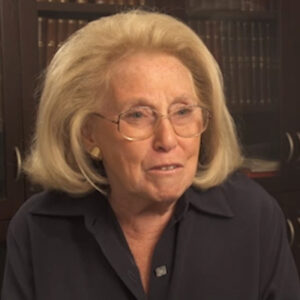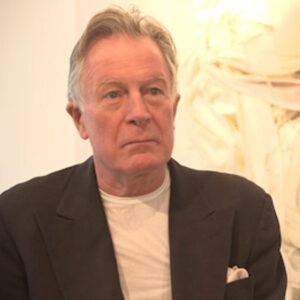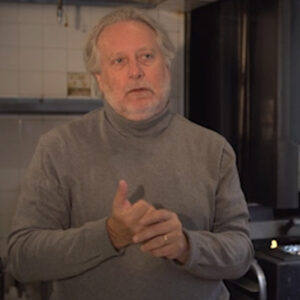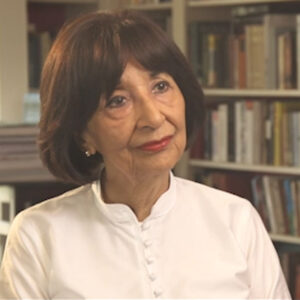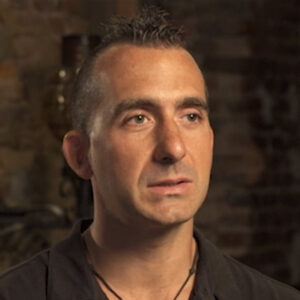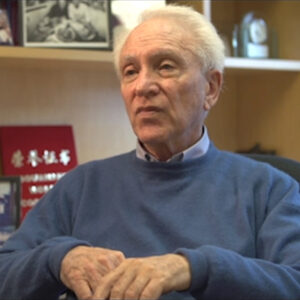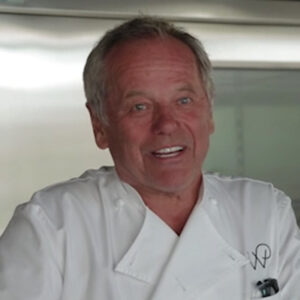Speaker 1 Now, James Beard didn’t come into my radar until I come to the US, but I definitely think then my mentor, such as Roosevelt and Michelle Gellar, who had a restaurant in New York in the late 70s, and Paul, because they knew of James beer very much. I came to New York in eighty two. I came to America in 1980 and in New York in the fall of eighty two. And he may have come to the restaurant. I just go to some events. I have participated for sure because early on I was involved also doing charity work and but I don’t recall having my picture taken with him and maybe celebrating with him. So I regret because I will well I would have loved to know him better.
Speaker 2 He spent some time in France in the nineteen twenties, um, can you describe some of the great restaurants and chefs during that time when James Beard might have been there?
Speaker 1 Well, I think it’s been many times in France, uh, maybe from the 20s, which I can’t really recall, uh, what, um, what it did there in France. But I can recall when he went also, uh, in the late 60s, early 70s, where he joined, uh, Simon back. And, uh, maybe there was also Juliar, I think, and and MFK Fisher and maybe him and other people around in Provence in their cars. And they were certainly thinking and trying to see how America could become a better country for food and what America will need to do in order to become a greater country. Uh, and I think they have really paved the way for what America is today.
Speaker 2 Mm hmm. Oh, can you could you just if you know a little bit about this coffee you describe for people who don’t know about places who have experience in the 20s when he was a young man studying.
Speaker 1 That’s right, because it did it did spend time in the palace of, uh, France and he worked at the Ritz, they worked or dined there.
Speaker 2 He died. Yeah. Some socialite lady.
Speaker 1 Right.
Speaker 2 Uh, just quickly tell our audience she doesn’t know.
Speaker 1 Absolutely important. And I think, uh, for James Beard, uh, is passion for food was, I guess, shown in a very early, not only early age, but in the 20s, uh, having gone in France and certainly witness Escoffier and the work he did with Brits and with child rates and, uh, certainly spent time at the restaurant of Escoffier and study also what Escoffier did for French cuisine, which was really transforming a certain classic way of uh, of approaching French cuisine. And as certainly the 20s there were a challenge in a generation, but also in a new world in a way, and how to rethink, uh, for this new world, a new cuisine. Escoffier could have coded all that. And I think James Beard was certainly inspired by the work then done by Escoffier there. And I think James B. Recoded America with cuisine thing. Uh following that with all the different um with all the different Buki brought on, on cooking and how he was certainly leaning on what he learned and what he could really study here and, and inspire. One line was so Auguste Escoffier was certainly one of the most influential chefs of the early century following that was found out following that was Paul Bocuse following. That is maybe a larger cast today. But Auguste Escoffier was the one who, after Garam and sort of the 19th century, was the chef in the 20th century who was really making rewriting the codes of French cuisine for sure.
Speaker 2 Can you tell us how there and look at the influence to the dining scene in
Speaker 1 New York City? Well, um, coming from coming from France, I knew that there was a very strong French dining scene in America, but I had to be here in New York and starting to work in New York to understand who was ungratefully. And and Zulay was the legend in French cuisine. He came in the late 50s, early 60s for the World Fair in New York and 40s. Thirty nine. Thirty nine. That was that one because there was the second one and then second. So he was the thirty nine. Yeah. And so. And is not always Razali sorry. So let’s start all over again. I mean, coming coming from France, I knew that there was a a very active and important dining scene and French dining scene in New York and in America and all this started with obviously when you came in the late 30s. Thirty nine for the welfare. And the French pavilion was basically managed by him and a holder of chef who came with him as well. They all came with a transatlantic crossing and arrived in Queens and started cooking there. And there was also Joseph as Agapa Franni and many chefs came at the same time work at the World Fair, and then they all came to town and started their own restaurant. Or Isolator was maybe the one who define at the time what the new French restaurant should be. And he also elevated is game to the finest, I think is really was coming from the lineage of Escoffier chariots. And he was really bringing that to New York. Um, of course he inspired so many other French restaurateur and chef. Sometimes they were chef, restaurateur, sometime they were Métro, the restaurateur. And that’s where all the legendary after a pavilion was like goodbye’s bars like hono like I have a love scene look very good. They all came as sort of disciple of Zulay, but not only in New York. You could see in Washington you could see in L.A. with lingerie with in Washington with Jean Pierre or a restaurant all over the world, all over America, or at least the greatest city were trying to imitate what they did with Le Pavilion.
Speaker 2 Did you ever meet him?
Speaker 1 I didn’t meet him because I was in America when, uh, but I learned so much. I mean, I never met Arvizu, but I’ve learned a lot of always relate through Piaf. And they Pierre was a very good friend and he was coming when I was a chef at Le Cirque here in this restaurant for six years. Pierre was coming to see me every Wednesday at the time with Craig Claiborne, who was managing the, uh, Craig was managing the New York Times food section in the early 80s. And Pierre, of course, the the at the time, Wednesday was the day I think they were maybe closing the section. And Pierre was always coming from Long Island to New York and see me because I think it’s so in me, a little bit of him in his younger days with Zulay and me at last year. And he was also a great friend of CIO. And so there was he was telling me a story about obviously has how much he was demanding man and a difficult man to please. And and he was not a chef. And I don’t think he could really understand the condition and the work a chef had to do in order to, uh, to accomplish what they wanted to accomplish. But at the same time, I think they were in great relation. Pierre was certainly after his time with them, was wanted to leave because he felt then he had done what he wanted to do with them, and that was it. I mean, I remember a quote he told me, which he told Zulay one day, Souley, ask him for something else. I mean, one day he asked for something to do and. And Pierre came to him and I think he had in mind to leave and Pierre came to him and say, I am sorry, Mr. Zulay, but. You cannot shave an egg because there is nothing to shave on it, and this is what’s happening to me. There is no more to shave
Speaker 2 on it or
Speaker 1 something like the expression was more about, you know, there’s not much to shave on an egg. And I feel like I’m an egg to the people. Yes, it was. But he was a legend and another story told me was interesting is that the pavilion was right across the St. Regis Hotel and that’s where I was. All I could bask after was there and. And the pavilion was owned by I don’t know who at the time, but there were a gentleman who was going to the pavilion every day and Souley at the door and that that’s the time where the door was what they called the wall. And unless you tip the maitre d or you really had a relationship or you were powerful enough in the world that they wouldn’t dare build a wall in front of you, it was impossible to break that wall. And you had the maitre d will make you wait. If he wanted to make you wait, the maitre d will decide which table you were going to go. And that gentleman who was coming there every day was always sitting in the back and was always treated like, you know, not so important for me. So you’re going to sit there and you’re going to be nice and we’re going to take care of you and everything. And it didn’t matter. I mean, at the time, maybe, of course, Zulay really created the power scene, the power lunch, the power seating and the real what they call the royale, which was, you know, there is an area in the restaurant where is the most powerful area. And if you really are powerful, you belong in the Royale. And that was the one we really created, that sort of era of attitude in front in the restaurant. And the old gentleman, when they called Mr. Zulay and say, oh, Mr. Zulay is always nice to be here. And I have a very good news. I just bought the building and your lease is for renewal. So I’m glad that we’re going to have to sit down and talk to each other. And that’s when the five of you want to get out and you move the pavilion to the Ritz Carlton, to the Carlton, the house or the to the Ritz building on fifty seven and Park Avenue in the corner of the northeast of the corner. And the there is there and you have the pavilion there for a while, but you kind of brought the magic of what the pavilion was about and then.
Speaker 2 Uh.
Speaker 1 After that of Basque, so I was in eighty one. In D.C. and a friend of mine was the pastry chef, I got back and we worked together in France that Valerie and Jean-Pierre say, oh, would you be interested to come and spend a month in New York and change our culture? Will love for you to come and do Therrien like you have learned to do at Asia and all that. So I came to spend one month at Liquid Bask in the late 80s or early 80s to. And that’s where I understood that this was the pavilion before and I was kind of riding on this legendary restaurant and these are sort of legendary space that was the pavilion. And I was totally
Speaker 2 are
Speaker 1 in awe and in shock of what a New York restaurant represented at the time. The kitchen was packed with chef and young chef like Todd English and Charlie Palmar. And I mean, they were all those this new guard of young American chef which really embraced and a trend that they were frank Crispell was there. And who else did I met? And I could see it then for me. Cooking in New York had to be a mission for me. I wanted to come and cook in New York. I don’t think I agree with what Leichardt best was, but I was very impressed by what liquid that could be represented as a restaurant. The wine cellar was packed with the best wine in the world. The clientele was incredible. The service, the the cooking, the food, and it was starting to change and trying to be a little bit more connected with what maybe was nouvelle cuisine in France. And, uh, uh, but, um, without going to like good Basque and kept you a little bit of this mystery of what the pavilion was and what it was, I don’t know if I would have come to New York ever. So it was, uh, it was a wonderful trip to have spent this month as I got Basque and eight months later, I came to New York and moved and never left.
Speaker 2 How many James Beard Foundation awards have you won?
Speaker 1 Um, well, I’ve won many and between me personally and me and the team, because we won for others, but I won, I think I had first the first one I got was when I was chef at Le Cirque. And so let me rephrase that, the first James Beard award I got was when I was chef and I had best chef in New York and they were really the top guns of New York. And I said, no way I’m going to get this award. I’m too young. And it’s my first time. And I won that. And I, I was so proud of that. And I think that was after about. For years, Atlas’s here for five years, then the second award I won was best chef in America and again against all the Top Gun in America, Chef were more established than me, bigger name than me. And I won at the first time. And I was just I couldn’t believe this could happen. And I was also the year I just opened my restaurant and that must have been ninety four, maybe ninety four. And I was ecstatic. I mean, it was very. And it was maybe the biggest day of my life for sure. Uh, then later on, I won, um, best restaurateur and that prize came with, um. Sort of Thomas Keller, one as best restaurateur, and I won, and then I think that was the last time that they included chef in that category only restaurant there as not cooking, chef, not cooking restaurateur. And but I was very proud of that, too. And of course, we got along the way, best restaurant in America, but that’s not the way we were like anxious to get into the the racing. But I think you have to be more than 10 years to be best restaurant and best service and best wine list and all those accomplishments. Of course it was me, but he was also the team. But some of the proudest moment as well in the Jem’s beer was when I moved Danielle to Sixty Fifth Street and took over last year. And I started cafe and I put the young chef their name on the wall camelina as Chef de cuisine, and a year later Iwon rising star chef in America. And to me it was to be able to choose a young chef who had never been a chef and to give him the tool and give him the support and give him the direction and to make him win. Then three years later, or maybe two or three years later, Up and DB Bistro and I place Jean-François Booligal, who was a young cook who came from France, a young chef, and. And he was assistant without a sous chef, became the chef, but also worked with me about five years before I became the chef at the Bistro and the following year he won the rising star chef in America. Now to the original, François is the chef de cuisine at Daniel for the last 12 years, but we have been 17 years together, so that’s how far we go and. On the can, Melanie left and I needed to choose a new chef and the new chef was Gavin Kason, I had never cooked in New York and never work with them again. But I was taking a chance to choose a young chef. And Gavin took over a cafe and a year later, one rising star chef in America. And I think to me. Everything you ever earn add a lot to do about maybe how that worked and the team might build and what I did, but for them to win that, I think he had a lot to do about giving opportunity and make sure that they could succeed with it.
Speaker 2 Tell us a little bit about the history that’s rough. Just be careful
Speaker 1 touching, leaning on. Oh, yeah. Yeah. Of creaking a little bit. Yeah, yeah, absolutely. Sorry about that.
Speaker 2 Tell us a little bit about the history of cinema or something else.
Speaker 1 Well, City on, which was established by James Beer and Gayle Greene in the early 80s and city meal sits from city meal will have been certainly an important factor for chefs, but also for the community for for me. I wanted to be involved with the community. And already, as a young chef in New York, I was involved with participating to some fundraising and gala. But I wanted to get more involved. And I really felt the city meal was caring for the people who were here before me, the people who really had a generation of children who are continuing to make New York City what it is and to be able to give my support because they care about giving them a warm meal was sort of a beautiful and logical story for me. And I’ve been involved with city meals for quite a long time because when 18 years ago, when I closed Danielle on 60, 70, 60 to move it to 60 feet, I decided to do a closing party. But then I said, well, why shall I add in an industry body later at night where we demolish the restaurant, basically? But then I wanted to do a closing event where it was meaningful also for the community. And we did an event with city meal and invited guests to pay to join us to close to the closing. Then when I reopened Danielle here the following year, we started our tradition of doing a gala dinner and a Sunday supper at Danielle. And that year I invited all my mentor from friends. So Babushkas was here, as you know, the home, which I was an apprentice in Leone, Josh Blong, Michelle Gellar was eventually they all came. And I say, you know, this will be an honor for me to cook for you. Don’t bring your chef jacket. Just bring your tuxedo, because you’re going to be invited to be in the dining room as guest of honor. And I think this was the most beautiful gala I’ve not the most, but one of the most beautiful gala we did. And every year since, I’m bringing a colleague, a friend, a chef, a group of friends to celebrate this Sunday supper and raise money for city meals. So in average, we have raised about, I would say, six to seven hundred thousand dollar every year with that over the last six years. So it has been very meaningful and very important for me to support city meals and serve all on one city for seventeen thousand. Eighteen thousand. You keep raising eighteen thousand mile a day.
Speaker 2 And what do you think that two million.
Speaker 1 Yeah, exactly. Yeah. When you see the importance of the program, city meals serve two million meals a year to about 18000 citizens of New York were elderly who cannot cook for themselves or get out of their house or may not have also a family to care for them. And I think this is an important cause for New York. And that’s my village, New York. So my title is co president and of course, my role is to support city mill, but also to engage with other colleague, other friend. And last year we started a program called Cheve. Deliver and Deliver is about engaging Chev to and in their restaurant to prepare some meal and deliver those meal just to understand even better what it is and the and the work of city meal every day, but also to bring a little bit of brightness and a little bit of contact and a little bit of joy to those people by having a meal prepared by the chef himself. I think there’s nothing more beautiful as a gift than to offer a meal prepared by you. And I think this is why Chef Deliver, I think is meaningful and chef like George Alfred Battal, Charlie Palmar and many, many Chef Cesari Cassella and participate in this program. And we have about 40 chef in New York participating and everyone take a lot of pride at making something special. Sometimes it come from being either very French or Asian or American or South American, wherever you are from, whatever, inspire you. As long as you don’t make it too spicy, as long as you don’t make it to esoteric, then it’s not going to be pleasure anymore. It has to feel homey also. I think it’s important.
Speaker 2 How do you get some of the recipients react? I mean, I know Ron is delivered some Meals on Wheels. Is someone like him coming? But how do they react when Daniel comes to their door?
Speaker 1 Oh, the the last delivery I did was with Marcus Samuelsson. And he was in a in a in a cold winter day. And we visited many of the residents of Harlem and they were so happy and the new of Markis restaurant, but they never got in because they can’t afford to get in. But they were passing by his restaurant some time. And so they were so excited to meet Marcus. And Marcus said, well, next time you stop by and that will make sure they’ll give you a little taste of something. You know, sometimes they’re frail and they they go around their neighborhood. It was very exciting. And I think they all are very touched. And we are bringing them something is done by us, chef. And they watch TV. They know some of the character are it’s it’s really a special day for them. And sitting beside, of course, bringing a meal. It’s also the human touch. It’s they come every day. People expect them. They have a little Shihad. They have a conversation, they feel connected, they feel connected. And if anything happened, they know what to do and they know who to ask. And demand is there to help them.
Speaker 2 Tell me, what inspired the chefs deliver them?
Speaker 1 Well, what what inspires chef driven program is that it’s about food. It’s what we do every day. Maybe for the more privileged one, we can afford to have our cooking. But Chef deliver was to try to give something homey to city meals. So it’s not we do a couple of hundred meals and this is multiplied by 40 chef over the 12 months. So every month there is a group of chef making meals are in the eighteen thousand meals a day. Then we distribute those couple of thousand meals may not be sufficient and it’s not the idea. The idea is to over the year make everyone benefit from the chef deliver in different parts of town. And it’s not only Manhattan, it’s also the five boroughs and the other the three bureaus around Manhattan. Um, no, it’s five boroughs. I’m sorry, Beth. Yeah, it’s not only Manhattan and our neighborhood, but it’s also the five boroughs around the city. And, uh. But yeah, let’s, um. But I think what the most important with shall deliver is the contribution we bring with directly going to the recipient. You know, when we call for a gala raising money for city meal and we are 30 or 40 chef, having our stations and people have pay to raise money, it’s one thing, but there’s not the same heartfelt connection than preparing something and knowing that we’re going to offer it to someone directly who can’t afford to have our own food.
Speaker 2 How do you think Mr. Baird would feel, seeing how the whole city.
Speaker 1 Well, I think I think James Beard was certainly the first who connected the community of chef and restaurateur with the city Meals on Wheels program because he was a man of good living. But also he wanted to make sure that every citizen deserved a good meal. And I think James Beard was certainly an inspiration with Gail in convincing the community of chef and restaurateur to participate with them and at making this program successful. So I think for chefs today, if we are doing chef deliver, it’s saying thank you to James for what he did when he started, for sure.
Speaker 2 What do you think is James Pyrates largest contribution to the American food scene today?
Speaker 1 Well, I think. For me, thinking about French cuisine, it’s about inspiring myself with the past as well from the past. It’s about inspiring myself from the past and looking at who was before me and what they did and how they were thinking and and really interpreting interpreting my take. And I think in America, when you look at the past and when you look at food and when you look at the people who really created what the world we have today, I think you think of James Beard. You think of, of course, Julia Child. You think of the people who really felt and we deserve a better world around the table or we deserve better food around the table. And I think there was no bigger advocate than him to do that. He was not shy at telling. You know, what do you think and and how you wanted to see America eating tomorrow? I think that was, I think his goal.
Speaker 2 Now, you’ve cooked at the foundation many times. What’s that experience like coming from your impeccable kitchen here?
Speaker 1 Well, no, no, it’s not that. But when you think of. The foundation and I knew the early I mean, we don’t talk often, I don’t know, but if you want but Peter Combs when he started that. But anyway, the foundation is not too many townhouse in New York where the kitchen take such an importance. And I think having created the James Beard Foundation there and left the kitchen, the way he had a James Beard, I think shows how much importance he was paying to cooking and how much, you know, you had to cross his kitchen in order to go to the to the garden in the back. And I think the kitchen was the epicenter of the house and every chef was there. My early days at the James Beard, I remember I say, well, I got to have new ideas every time I’m going to go and cook there. And at the time, luckily from luckily, tomatoes were starting just as the young suppliers of tomatoes. She was having a brother driving to Florida to bring ripe tomato to New York and back and forth and and then try to find local farmers here to grow the beautiful tomato. And I told Lucky, I say, why don’t we do the James are together and we do a no tomato menu. And that became a tradition. So for many years with the hundred percent tomatoes, eight course menu or seven course with just tomato, including a dessert like a lemon tart with tomato, coffee and basil. And we started with a chilled tomato soup. And they were all classic French dishes in a way, but just with tomato. And we had a blast. Mean, um, and I think for the James Beard is is really the house for every generation of chef, even a young chef today was just starting to be known is the dream is to go and cook, get the James house, and his dream is to become a great American chef. And I think is the rite of passage as a young American chef, if you want to earn recognition and if you want to earn the respect and if you really want to fulfill your dream, you have to go get the James Beard.
Speaker 2 What do you want to ask about one thing? Did you kill him because
Speaker 1 no, I don’t know, maybe. But she was
Speaker 2 a food editor at Recall’s and Home and Garden, and she’s very good, friendly, sharp chocolate and pretty much introduced. She is.
Speaker 1 I know there are no words.
Speaker 2 And then can you just describe for people who don’t know what new cuisine was an important.
Speaker 1 Absurdly. So. You know, I’m a. Child of nouvelle cuisine, because when I started cooking was in nineteen sixty nine and nouvelle cuisine really exploded in the late sixty eight, sixty seven, sixty eight and early 70s and the entire 70s, there was really the decade of nouvelle cuisine in France and nouvelle cuisine apon first because chef was starting to travel Bocuse leader of the pack Michelle Gellar and I saw the horse and, and a whole generation of chefs started travel and learning. And also I believe then they were Japan having a very big influence on the French. Um, at the time, Mr Souji, who has one of the most important cooking school in Japan, was spending a lot of time in France and bringing French chef to Japan. And by the time we were in the early 70s, every French restaurant had at least two, at least two Japanese cook, which was sent from Japan, where they were fully financed by hotels and chefs and and restaurants in Japan to learn about French cuisine. And I think the French going to Japan. Understood. Then there could be something beautiful and traditional and modern at the same time established. And that’s when also they learn about Kanzaki Munu, which became the Gusterson. But the real, um, the real impact of French cuisine and ah, it got famous was because of the media and because of Gameel. And they were too young guy. We were starting a magazine about food, about restaurant, about travel, about wine and ah and were really creating sort of the new Óscar of of French cuisine in France. And they and and I think what really made the movement. Together between what the chef experienced, travelling the media, supporting them and and locally becoming big inspiration, I think it was this camaraderie and this friendship among all of them where they were really. A group of they call it the Bocuse and Babushkas was the leader, but everyone federated behind him and and sort of listened to him in. And then you had artist Woo! It was not about trying to cook the same food together, it was all about trying to express yourself the best way possible.
Speaker 2 Describe the food,
Speaker 1 of course, so, yeah, that the water was definitely I mean, nouvelle cuisine was a departure from, uh, from the classic from the more continental cuisine. I remember when I arrived in New York are all the rest of the generation of Zulay. We’re all doing the same kind of food. The menu was very predictable. They had Solvay on the back. They had they were all doing souffle. They were all doing classic dishes, which came from more like the cruise ship, more like the generation of the palace. It was it was the generation of Escoffier. I mean, the Escoffier cuisine, what was going on. And, uh, and nouvelle cuisine was about breaking off from that generation. And it took about 10 years in America to have a generation of chefs like me, Jean George and even Thomas Chaloner to go and learn in France and bring it back here, this sort of new way of thinking about food and and really creating very light, very unobstructed often and and maybe more regional and more personalized cuisine, but using classic technique. Of course, um, you go back to the Fratelli goal in nineteen sixty eight sixty nine, when they created the scale of the tomatoes and, and the scale of the tomatoes, they was nothing more than a slice, a thin slice of salmon on a warm plate, just slightly flash into a salamander and and put a serious source who was delicate, I mean beautifully made with perfect reduction then and but the cream, everything was light and beautiful and fresh and unique. And the salmon was barely cook. And this was sort of a departure from the classic somewhat of a maybe then Escoffier would have done with a very avy uh so Suparman very or so overblown. And certainly, uh, Akwesasne was not in control as much as what nouvelle cuisine was trying to apply, where there is precision, lightness and um and personality was really coming into place.
Speaker 2 So one less connection would be that, you know, you don’t really professed to be doing a little used to it. You have the perfect food. And I think that he was talking about like that is very much.
Speaker 1 But that also you have to realize then, uh, James Beer was not professing are old cuisine as much as he was professing soul food, French cuisine and how regional French or traditional home cooking sometime are, or maybe or a certain way of looking at what market do you live in and what how do you cook directly from the market, from for these local farmers, local producers. And I think you saw that in in France, um, the way of leaving was to go to the market in Italy as well in in many of European region. And I think Jem’s b, I wanted to make sure that people were remine. Then in order to do great food at home, you had to have great ingredients and those great ingredients, you have to work hard at finding them. You have to travel, you have to search, you have to want to find the best ingredient. And I think this was really, um, because, uh. French chef, it don’t matter if they were cooking and I think what cuisine in France, it was always all about the ingredients and the technique, but they were time, maybe a little bit more avy and the preparation was maybe a little bit more too complex. And you lose the beauty of the simplicity. And I think nouvelle cuisine help really balance that. But what I believe is then of all the other country at the time, France was the only one where gastronomy and old cuisine, Italy, they had regional cuisine. They had really a cooking of their own. And but they didn’t really have the gastronomy. And that’s why in the 70s and when nouvelle cuisine started in France, then, of course, other countries wanted to be. Part of this movement, but they were really creating a French restaurant in their own country. They weren’t really creating what they, you know, or Italian or German, nor that it’s really individual and it’s much more personalized. And even in America today, an American restaurant, gastronomic restaurant or a great American restaurant today is not modeled only after the French. It’s today. It’s modeled after from where you are, the you think of of your land. You think of the U.S. story and you think of the past, but you also inspire you with the with the vast community and the travel. And, you know, I think I think today I see it. And there is Japanese influence into American restaurant. There is French influence, there is Scandinavian influence, there is Asian South American sometime. And, um, and everyone try to maybe pick the best out of that and create something very special. And I think that’s that’s beautiful because that shows how much evolution there is in dining in America.
Speaker 2 Understood, man.
Speaker 1 And I knew I knew about this young man because, you know, I’m sorry, with this table. I knew about this young man because I worked at Muja with Valge and address your man at a house there and the year I came to America in 1980, I think that’s the year Andre opened the restaurant in Muja as well. He was, I think, retiring from New York, left the partnership with all the resort there and went to Muja Annapurna restaurant. And of course, I had a chance to see him. And actually I saw that I saw a couple of years ago he was in New York and came to see me again. I was a very young chef at the time, but I knew of the history of racism in New York, um, and I think racism. And I thought there were maybe quite different than the rest of the restaurant of the Suli school. I will say, I don’t think saw a man was a protege of Zulay, neither Andre Sautner. And so they were really creating something of their own there. And, um, of course, after when I I was the chef at the plaza, the name. And within the same week, because I guess they heard then there was some change of management at the plant that Danny and I really started to make my mark as a young chef in New York and within the same week on the resort there and see you. And he made me an offer to come and be the chef in their restaurant. And so our interview with Andre Sautner and I knew then it was still too young to quit and and that he was going to be the chef and I was going to be maybe chef de cuisine. But then I had to do maybe more of its cuisine than trying to really express myself in. And, of course, an interview with you. And I understood that he wanted the chef to cook his heart out and to really, um. And so you always was inspired by the transformation of restaurant and cuisine in France and wanted to catch up quickly, and you always felt then, um, by bringing me, you will be an opportunity to really capture a little bit of what nouvelle cuisine represented, but mostly it’s transformation from classic to more actual and. Moore may be angry, driven and trying to find better local suppliers as well and and do a more personal cuisine in a way.
Speaker 2 Four in one sentence for people who don’t know anything about the test. Why? Why the tests and so many were.
Speaker 1 Well, yeah, because I think obviously the rest of all. Represented luxury, but represented also what may be the parece represented, which was legal, lost, all in all its blather and in all its service and food outlets, Alzner and other outlets, Yoma. And although I thought it was more about going to their home, you enter. It was more like a provincial restaurant where you drove for a couple of hours and you arrive in this wonderful home and everything is about. The chef is cuisine, is there well, and it’s about service at the highest level, but in a more provincial way in comparison. Other school day was a very urban restaurant, restaurant for businessmen, restaurant for, um, the the powerful elite of New York or the world. And Andre Psalter, it was more about, you know, it’s me and my wife and come to my home.


